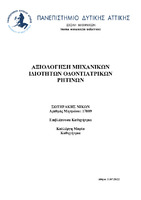| dc.contributor.advisor | Kallergi, Maria | |
| dc.contributor.author | Σωτηράκης, Νίκων | |
| dc.date.accessioned | 2022-07-20T10:21:23Z | |
| dc.date.available | 2022-07-20T10:21:23Z | |
| dc.date.issued | 2022-07-11 | |
| dc.identifier.uri | https://polynoe.lib.uniwa.gr/xmlui/handle/11400/2576 | |
| dc.identifier.uri | http://dx.doi.org/10.26265/polynoe-2416 | |
| dc.description.abstract | Ο σκοπός αυτής της εργασίας είναι να μελετηθούν και να αξιολογηθούν οι μηχανικές
ιδιότητες δύο ειδών οδοντιατρικών ρητινών, των μικροϋβριδικών και των
νανοϋβριδικών. Η αξιολόγηση αυτή στοχεύει στο να απαντηθεί το ερώτημα αν οι δύο
αυτές ρητίνες έχουν σημαντικές διαφορές που μπορούν να επηρεάσουν την
αποτελεσματικότητα τους ανάλογα με το σημείο στο οποίο θα τοποθετηθούν.
Τα υλικά που χρησιμοποιήθηκαν στην έρευνα αυτή είναι μία μικροϋβριδική ρητίνη,
μία νανοϋβριδική ρητίνη, ένα καλούπι εξαγωγής επιθυμητού μεγέθους ρητινών, δύο
συσκευές φωτοπολυμερισμού (μία με λάμπα ιωδίνης και μία με λάμπα LED), ένας
οδοντιατρικός μικροκινητήρας για την λείανση των ρητινών, και ένα σκληρόμετρο για
την μέτρηση σκληρότητας των ρητινών εφαρμόζοντας μέθοδο Vickers. Η μεθοδολογία
που ακολουθήθηκε για το βέλτιστο δυνατό αποτέλεσμα ήταν αρχικά να δημιουργηθούν
δείγματα ρητινών με συγκεκριμένο καλούπι, στη συνέχεια τα δείγματα να
πολυμεριστούν και να λειανθούν και τέλος να σκληρομετρηθούν. Τα αποτελέσματα
καταγράφηκαν και αναλύθηκαν ανάλογα με το είδος και το πάχος των ρητινών και την
μέθοδο φωτοπολυμερισμού με περιγραφική στατιστική. Διαφορές μέσων τιμών
αξιολογήθηκαν με το student t-test.
Σύμφωνα με τα αποτελέσματα της σκληρομέτρησης, η νανοϋβριδική ρητίνη
παρουσιάζει μεγαλύτερη σκληρότητα από την μικροϋβριδική ρητίνη ανεξάρτητα από
την μέθοδο πολυμερισμού. Λαμβάνοντας υπόψη και το κόστος των δύο ειδών ρητίνης
προτείνεται για μικρά πάχη να τοποθετείται νανοϋβριδική ρητίνη ενώ για μεγάλα πάχη
να τοποθετείται η μικροϋβριδική καθώς φέρει τα ίδια αποτελέσματα. | el |
| dc.format.extent | 55 | el |
| dc.language.iso | el | el |
| dc.publisher | Πανεπιστήμιο Δυτικής Αττικής | el |
| dc.rights | Αναφορά Δημιουργού - Μη Εμπορική Χρήση - Παρόμοια Διανομή 4.0 Διεθνές | * |
| dc.rights.uri | https://creativecommons.org/licenses/by-nc-sa/4.0/deed.el | * |
| dc.subject | Οδοντιατρικά υλικά | el |
| dc.subject | Ρητίνες | el |
| dc.subject | Νανοϋβριδική | el |
| dc.subject | Φωτοπολυμερισμός | el |
| dc.subject | Λάμπα ιωδίνης | el |
| dc.subject | Λάμπα LED | el |
| dc.subject | Σκληρομέτρηση Vickers | el |
| dc.subject | Dental materials | el |
| dc.subject | Resins | el |
| dc.subject | Microhybrid | el |
| dc.subject | Nanohybrid | el |
| dc.subject | Photopolymerization | el |
| dc.subject | QTH | el |
| dc.subject | LED | el |
| dc.subject | Hardness test | el |
| dc.subject | Vickers | el |
| dc.subject | Μικροϋβριδική | el |
| dc.title | Αξιολόγηση μηχανικών ιδιοτήτων οδοντιατρικών ρητινών | el |
| dc.title.alternative | Evaluation of the engineering properties of dental resins | el |
| dc.type | Διπλωματική εργασία | el |
| dc.contributor.committee | Kalyvas, Nektarios | |
| dc.contributor.committee | Σκουρολιάκου, Αικατερίνη | |
| dc.contributor.faculty | Σχολή Μηχανικών | el |
| dc.contributor.department | Τμήμα Μηχανικών Βιοϊατρικής | el |
| dc.description.abstracttranslated | The purpose of this thesis was to study and evaluate the mechanical properties of two
types of dental resins, micro-hybrid and nano-hybrid, in order to determine their
differences and correlate them to their relative effectiveness in tooth fillings.
The materials used in this research were a micro-hybrid resin, a nano-hybrid resin, an
extract mold to develop the desired resin shape and thickness, two light cure units, one
of which uses quartz-tungsten-halogen (QTH) and the other a light-emitting diode
(LED) lamp, a dental micromotor for treating and polishing the resins, and a hardness
testing machine to measure the hardness of the resins with the Vickers method. The
experimental protocol included resin extraction and molding, polymerization,
polishing, and hardness measurements. The hardness results were analyzed as a
function of resin type, resin thickness, and curing light with descriptive statistics. Mean
differences were tested for significance with the student t-test.
Results showed that the nano-hybrid resin has higher hardness than the micro-hybrid
one independent of the light curing method. Considering the higher cost of the nanohybrid resin, however, it is suggested that the nano-hybrid resin is used for small
thickness fillings while micro-hybrid resin may be used large thickness fillings with
similar effectiveness. | el |


